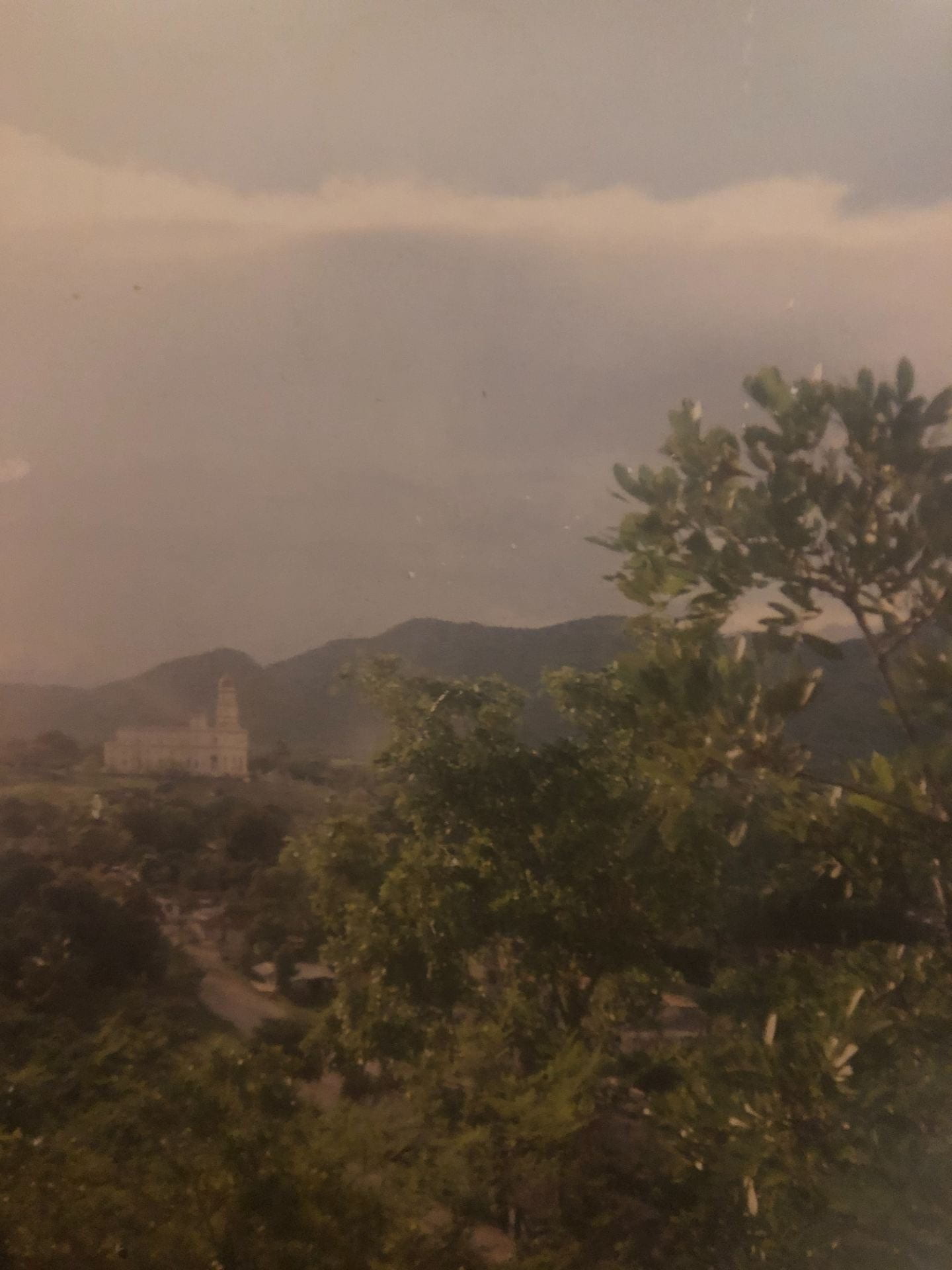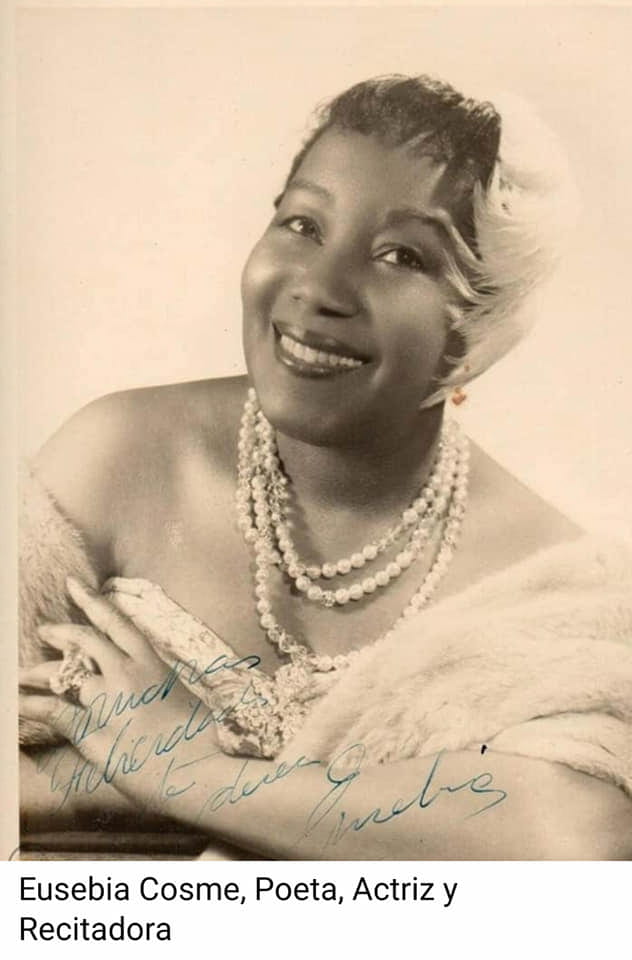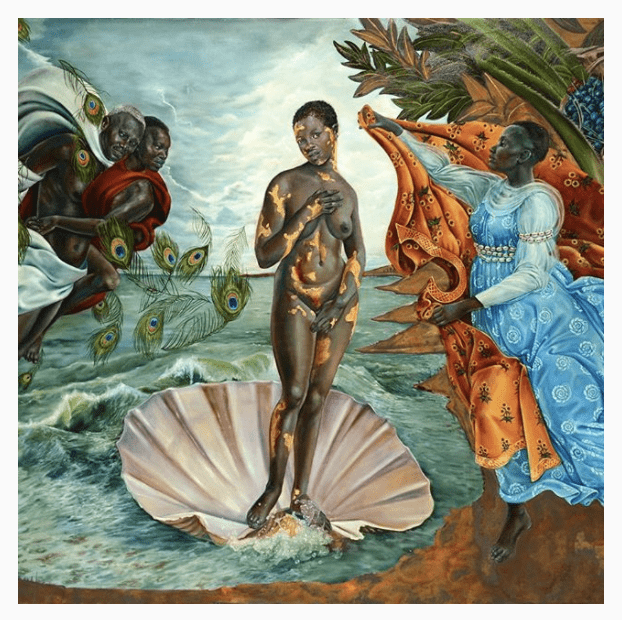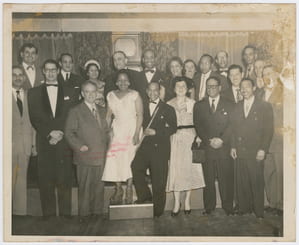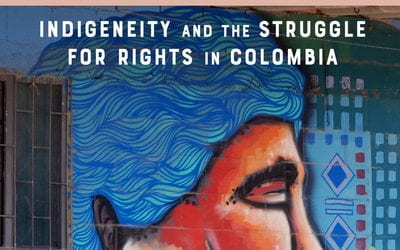Eusebia Cosme and El Cobre:
Performing Sacred Histories
Muddy water rippled like brown skirts surrounding our small boat on the Toa River, where the river meets the sea in rural Cuba. My eyes traced the outline of the trees from the cacao farm where we disembarked, over to the stretch of the Sierra Maestra mountains in the distance. I paused, inhaling the natural beauty of these shores. I felt currents from Inagua to Jacmel from the river, where just north of here, three enslaved young men working in local copper mines set sail to find salt in Nipe Bay.
In 1612, Juan and Rodrigo de Hoyos, two indigenous brothers traveling with a 10-year old black criollo named Juan Moreno, planned their return when a storm arose. Their boat swayed violently in the waves. That was when they saw the statue floating in the water with the inscription “Yo soy la Virgen de la Caridad” – I am the Virgin of Charity. The three Juanes brought the statue back safely to Barajagua, the Virgin’s first home before moving to El Cobre. When I arrived to El Cobre a day or so after canoeing the Toa, I climbed up to her sanctuary, nestled high in the mountains. Our bus driver asked our group of students visiting the island “Ustedes son creyentes?” – Are you believers? “Si,”—yes, I responded for myself, never having imagined that my promesa would lead me to study Eusebia Cosme; an artist and native of the region who was honored as Santiago de Cuba’s Favorite Daughter amidst the Virgin of Charity’s coronation in 1936.
I remember my pilgrimage to El Cobre as I have tried to envision Eusebia Cosme’s early life while researching the arts in transnational Cuban communities. I was surprised to learn that Eusebia Cosme, one of the world’s most famous declamadoras of Afro-Antillean poetry in the 1930s and 40s, was among few black artists who performed in both white and black Cuban mutual aid clubs in the United States. Cosme’s life interrupts the archival silences about black women artists who lived through this era, but there are few publications about her formative years. My waning memories of my last visit to Santiago de Cuba nearly two decades ago have caused me to wonder how Cosme’s upbringing influenced her spiritual performances of Afro-Antillean poetry.
Eusebia Cosme y Almanza was born into a black working-class family in Santiago de Cuba sometime between 1908 and 1911. Her parents Germán Cosme and Leocaldia Almanza earned their living working at the estate of the Marcané family, a white aristocratic family led by patriarch Luis Fernandez Marcané, a prominent legal scholar and writer elected to the Cuban senate during the 1930s. Tragically Germán and Leocaldia both died before their daughter grew up and the loss of her parents must have been difficult for both Cosme and their families, and so grief is another layer of Cosme’s life as a declamadora. As Antonio López tells us in Unbecoming Blackness (2012), the Cosme y Almanza family’s hard work led the Marcanés to sponsor Cosme’s formal education in the 1920s. Even though the Marcanés supported Eusebia Cosme, the Cosme y Almanza family story is still significant since they lived through vital spiritual, political and economic shifts that marked the end of Spanish colonialism in Cuba.
The Cosme y Almanza family may have its ancestral roots in El Cobre, a small copper mining town northwest of Santiago de Cuba. As historian María Elena Díaz discusses in The Virgin, the King and the royal slaves of El Cobre (2000), “royal slaves” in El Cobre were colonial subjects of the Spanish king who had a unique social and political position. They had a direct line of communication to the king as well as complex families made up of slaves and free people of color. Royal slaves owned property, including other slaves, which challenges our popular notions of slavery today by urging us to think through the landscapes of marronage, when enslaved people escaped slavery by settling in the mountains. Cobreros and free people of color used their mobility as a strategy to politically pressure the monarchy and to fight for their freedom.
The Cosme family gained influence within the slave royalist community by passing on land and slaves through births, deaths and marriages. They formed part of a core group of local families whose royal status enabled them to grant freedom to other family members (coartación) since the era of the Three Juanes. In 1739, another Eusebia Cosme lived and as the eldest sibling of her family, inherited her family’s properties, including slaves, after her father’s death. The story of two Eusebia Cosmes has currency whether there is a blood family connection or not, because it gives us insights into early forms of black feminism, where black women created their own sense of possibility across space and time in the Oriente, the eastern part of Cuba.
Gregorio Cosme Osorio was a free man of color who emerged as a local leader in El Cobre during the 1780s, and may have also been an early ancestor of the Cosme y Almanza family. Having grown up amidst generations of struggle for autonomy and racial equity, Gregorio Cosme advocated for cobreros – the people of El Cobre — from the island so successfully that he left Cuba to live in Madrid, Spain in order to serve as an official legal representative (apoderado) of their community. Together, they made several direct petitions to the crown for El Cobre’s independence, and won in 1800.
As anthropologist Jalane Schmidt carefully narrates in Cachita’s Streets (2015), the cobreros‘ growing devotion to the Virgin of Charity gradually reverberated politically and spiritually throughout the nation. The cobreros honored their legal victory in step with the local tradition of honoring the Virgin, known for performing miracles since her first apparition in Nipe Bay. The oral storytelling about the Virgin’s miracles, Afro-Catholicism coupled with espiritismo (spiritualism combines mediumship and African Indigenous healing), and Congolese spirituality came together in daily black religious life and popular devotion. Catholic-Congolese spirituality existed prior to the Virgin of Charity’s later syncretization with the orisa Oshun, who represents inheritance, love and sensuality, when Afro-Cuban Lucumí gained popularity in the eastern provinces during the 20th century.
Acts of devotion to the Virgin and saints created intimacy among the spiritual realm, ancestors and the devotee. Since the Virgin’s arrival to El Cobre people of multiple faiths have traveled to her sanctuary to leave offerings such as clothing and flowers or to light candles with the hopes of resolving problems with health, finances or a loved one. Thus faith and belief in Cuban spirituality, and throughout Latin America and the Caribbean, has emphasized the body and action, where practitioners use personal agency in order to resolve spiritual matters and to communicate with sacred realms.
These Congolese-Catholic based spiritual practices were common during Eusebia Cosme’s parents’ lifetimes. Germán Cosme may have carried the image of the Virgin of Charity when he served in the mambises army which was popoular among soliders fighting in the Cuban War of Independence from 1895-1898. On some of the few occasions the Virgin has left her sanctuary, the mambises brought her to battles during their revolutionary wars for independence from Spanish colonialism. After the wars they supported efforts calling for the Catholic Church to officially recognize the Virgin of Charity as Cuba’s patron saint.
Eusebia Cosme may have also heard her father refer to the cigar factory workers in Key West and Tampa, Florida, before she moved to New York City in 1938, where she quickly rose in importance as a member of transnational Cuban social clubs. The Cosme y Almanza family’s black contemporaries living in the diaspora founded mutual aid clubs where a few decades later, Cosme emerged as a pioneering black artist.
In More Than Black: Afro-Cubans in Tampa (2002) anthropologist Susan Greenbaum studies Jim Crow’s impact on Cuban and Bahamian immigrants who made up a significant percentage of the cigar industry workforce during the economic boom of late 19th century. Black immigrants worked in integrated spaces at their jobs, but could not study, join the same clubs or attend church with their white co-workers. In this enclave, couples such as Ramon and Susan Valdés, both Afro-Cuban immigrants, played a significant role in fostering sacred spaces. They co-founded St. James Episcopal Church in 1892, the first black church in Tampa, and with fellow working-class and professional immigrants, including doctors, teachers, artists, they founded the Sociedad Union Martí-Maceo in 1904, the first Afro-Cuban mutual aid club in the United States. In his memoir Black Cuban, Black American (2000), Evelio Grillo personally remembers attending weekly séances or misa espirituales with his mother while growing up in Ybor City. Diverse clients sought out Afro-Cuban women espiritistas to help them resolve their daily life issues.
Similar dynamics of spiritual life and racial disparities in Ybor City certainly resonates with the history of El Cobre and eastern Cuba. As Cosme became a integral member of the social clubs, she further cemented those connections in her fluidity living between black working-class and white elite spaces. This movement propels Cosme’s artistic trajectory forward and prepared her to navigate the racial and gender politics of the social clubs and performing arts in New York City. Interestingly enough, before Eusebia Cosme moves abroad she experienced a definitive moment of Santiago de Cuba’s religious history which reverberated throughout the nation.
After Eusebia Cosme studied music and declamation in Havana in the early 1930s, she briefly lived with her aunt in Santiago before she toured the island and the Caribbean. Therefore, it was an enormous honor when the city of Santiago de Cuba recognized Cosme as a Favorite Daughter (Hija Predilecta), which occurred within a month of the Virgin of Charity and Remedies coronation. The Eucharist Convention happened on December 20, 1936, and lasted for four days revolving around the ritual of crowning and adorning of the statue of the Virgin. Local government officials led public processionals and gave speeches that represented the white elite leadership’s efforts to maintain a racialized social and political order which publicly rejected black cultural and spiritual practices.
Blacks and mulatos did not typically baptize or confirm their children in the Catholic Church and represented a small portion of parishioners. In contrast to the official state religious celebrations, black people hosted their own local saint feast celebrations with music, sweets, special meals and misas de veladas at midnight. Cosme’s public recognition, given the racial and spiritual layers of the coronation, takes on more significance as her family story becomes part of the official narrative of her natal city’s history. Its visiblity also opened doors for future generations of black women artists, including a brilliant vocalist born during the coronation festivities named Guadalupe Victoria Yolí Raymond, known as “La Lupe”.
Afro-spirituality a lo Cosme happened as she moved back and forth from eastern and western Cuba, toured cities in Latin America known for their black presence, and recited in racially segregated social clubs, which she narrated through poetry, sound, costumes and rhythms. Cosme wore colorful dresses that had rumba and folkloric aesthetics, with ruffle sleeves and handkerchiefs or shawls around her shoulders. She developed a style that black Cuban women performers made fashionable. Cosme’s spirituality was alive in her poetry, and lived in her mastery of complex poetic meters including her original compositions that used son, rumba and popular Afro-Caribbean rhythms. New waves of Jamaican, Haitian and other West Indian laborers brought their sacred music and religious practices to Cuba in the 1920s. As an artist Cosme created Afro-Antillean recitation by translating local oral traditions, folklore and popular music into her repertoires, weaving son cubano, décimas and spiritual chants into a seamless tapestry.
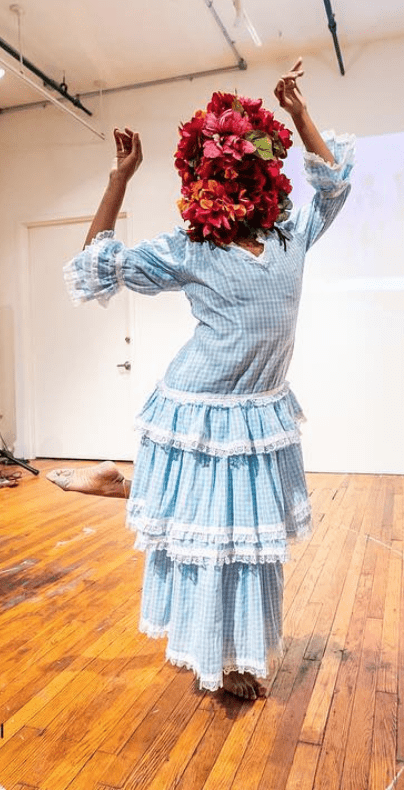
A contemporary example of an artist following in Cosme’s NYC legacy; photo by Beatrice Capote Reyita
As we’ve seen, Eusebia Cosme’s story begins in Santiago de Cuba, where she first learned to channel local sacred histories into her craft. Cosme’s life also embodied the Marian principles of devotion to the Virgin Mary present in the oral histories about the miraculous Virgin of Charity and Remedies. Surely Eusebia Cosme’s parents would have been very proud of their daughter’s success had they lived to see it, and so we should honor the Cosme y Almanza family legacy in regional sacred histories when we remember Eusebia Cosme’s extraordinary life.
Winter 2021, Volume XX, Number 2
Jadele McPherson is an artist-scholar whose research focuses on the intersections of sound and healing, mutual aid, and performance in Florida, Haiti and Cuba. She is currently a PhD student in the CUNY Graduate Center Anthropology Department and teaching fellow with the Mellon Seminar for Collaborative Research and Engagement where she is researching how sound impacts wellness, climate change & environmental sustainability. Currently McPherson is producing the 3-part series Mind, Body & Soul: Afrofuturist Sacred Sounds, featuring Afro-Latinx artists and scholars who discuss their creative processes and wellness while living through the pandemic.
Related Articles
Indigenous Peoples, Active Agents
Recently, the Amazon and its indigenous residents have become hot issues, metaphorically as well as climatically. News stories around the world have documented raging and relatively…
Beyond the Sociology Books
If you are not from Colombia and hoping to understand the South American nation of 50 million souls, you might tend to focus on “Colombia the terrible”—narcotics and decades of socio-political violence…
Exodus Testimonios
The audience at Iglesia Monte de Sion was ecstatic as believers lined up to share their testimonials. “God delivered us from Egypt and brought us to the Promised Land,” said José as he shared his testimonio with the small Latinx Pentecostal church in central California…

